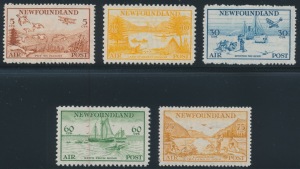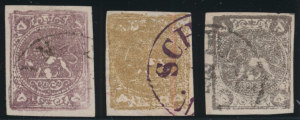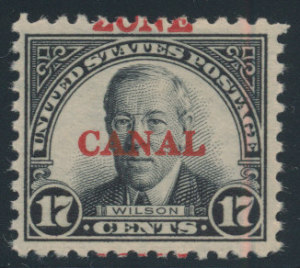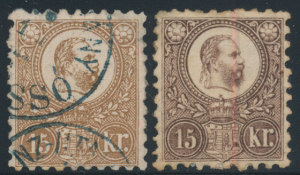In the 1970s Public Auctions were much more frequent (and there were far more philatelic auction companies) and there was no Internet. Auction firms sent out a thousand or so auction catalogs to their best customers and mainly solicited bids by mail. There was no email or fax machines, few phone bids and no live computer bidding Because of these factors there was spotty coverage at many auctions and many lots really did sell cheaply.
In 1976, I was in London bumming around a bit after college. I supported myself by doing a bit of stamps, going to auctions. But life then didn't require much support- Europe for an American in those days could be very cheap. I was sitting at a H R Harmer auction in London. Harmer was one of the "venerables"- one of several old line English auction firms that went back to the earliest days of our hobby. Their auctions were stuffy affairs and I was the only person in the room that day under
Monthly Archives: October 2011
- Posted October 31, 2011Read more »
- Posted October 30, 2011Read more »
Most people involved in this hobby are glad to tell you of their great finds. Last week John Murray died and he was involved in one of the great finds of the last thirty years in the entire hobby of philately. And it was at my expense. In 1995, I bought a pretty mediocre quality US collection at an auction in Switzerland. The dollar was very strong in those days and I went to Europe quite often to buy stamps for resale. This particular collection looked to me to be nothing special but I made a big mistake when I didn't carefully check the One Cent 1851s. The collection in question sold for about $1500 to a Houston collector John Murray and he carefully checked the stamp that I should have and found it to be a variety, Scott#5. The stamp was worth $40,000 and John had bought it in a lot where he had paid about $10 for that particular stamp. Most of our lots don't work out that well for the buyer but John Murray could tell you that he probably got more value from that auction lot than from
- Posted October 30, 2011The stamps of Newfoundland have always been a favorite with philatelists. The internal demand in Newfoundland itself is small because the population of that province is small but the philately of Newfoundland is interesting and has always attracted Canadian collectors, British Commonwealth collectors and US collectors. The stamps are interesting and well engraved. The first issues are very scarce and have some of the rarest stamps in philately although listing major catalog numbers based solely on paper and shade differences has always seemed silly to me. Stamps printed from the same plates and of the same denomination and color should generally be the same major catalog number and varieties of paper and shade should be minor "a" numbers. This is not the case with the first issues of Newfoundland and collectors do not readily take to these stamps. The twentieth century issues are very well engraved and tastefully designed and have always been avidly collected.Read more »
- Posted October 29, 2011The popularity of a country's stamps varies with the popularity of the government in power. Japanese stamps were very popular in the 1920's and fell off tremendously in the the 1930's and 1940's before renewing their popularity after World War II. The stamps of Iran were very popular until the last twenty years. They are among the world's most interesting. The classics are complex, hard to find and yet not very pricey. Called the Lions they have that primitive quality that makes the Nineteenth Century philately of many countries so alluring. There were many printings and considering how rarely they are offered for sale, prices are surprisingly modest. There are two reasons for the low prices. First is the political unpopularity of Iran in the world makes for few new collectors of this area. But more importantly the popularity of a country like Iran (or China or India) is aided by a successful emigrant community that often seeks the stamps of the home country. Iran has been underRead more »
- Posted October 28, 2011Read more »
The world is just a few dictators away from a radically different Arab world. Americans are fond of thinking that it is something peculiar to our character that has made this country great. Perhaps so. But never underestimate the significance of good government (Good government believe it or not is what we have. It is defined not so much by its dysfunction, of which we have plenty, but by the reason why politicians go into government. In our country most politicians go into government to serve and create a better society however they define that. In many third world countries people go into government to enrich themselves. It is a huge difference). Now that Egypt, Tunisia and Libya have replaced their dictators there is a chance that those countries can get good governments and enjoy the kind of economic growth that good government allows. Since this is a blog about stamps, here's the philatelic angle. I would be buying the current issues of these three countries and selected
- Posted October 27, 2011Read more »
Bill Evans was a already an avid collector when he started coming to our auctions some thirty years ago. He was of Hungarian descent and gravitated towards Hungarian philately. He became particularly interested in a specialized area of Hungarian philately called Hungarian Occupations - hundreds of different stamps issued in the aftermath of WW I for various areas that obtained temporary sovereignty due to the disintegration of the Austro-Hungarian Empire. These are very complex issues with many rarities and many forgeries and Evans had the fire and intellect to make a good go of this area.
As luck would have it in the late 1980s we were selling the Hungarian Occupation section of the reference collection of Herbert Bloch. Bloch, who I have written about before, died in 1987 and was one of the top world wide experts(he had studied with professionals in an unbroken line from the very first philatelic experts). His reference collection contained tens of - Posted October 26, 2011Read more »
The most basic decision that most collectors make is whether to collect stamps mint or used. In the very earliest stages of collecting either will do and, at the very highest stages, finances often force either to do. But most collectors start saving both and then gravitate to one or the other. The decision comes down to a calculation. Used stamps are usually cheaper and require less care in mounting and handling. If I were putting away stamps long term for an investment portfolio I would only select used as with mint stamps gum grading standards have changed dramatically over the years and are likely to do so further in the future. Gum can degrade over time if not stored carefully and even the smallest amount of humidity can cause toning. Since so much of the value of a mint stamp today is in perfect gum I wouldn't want to have to worry about this as a long term investment. Used stamps are easy to store and harder to damage. You probably shouldn't try this at home but if
- Posted October 25, 2011Of the major world wide powers in the philately era (that is since 1840) the least imperialistic has been the United States. Great Britain and France had between them hundreds of imperial philatelic entities. German was a big player and even Italy, which had more of an appetite for conquest than the digestion, had fifty or more imperial philatelic areas for which she issued stamps. Partly because our own internal markets were so large, partly because of immigration, partly because of endless land to be developed and maybe a bit because of our democratic aspirations, America was a far smaller player in the Imperial game than our European competitors. This changed a bit in the late Nineteenth Century when the Spanish American war gave America three colonies - the Philippines, Cuba and Puerto Rico. These colonies were largely not-for- profit imperial ventures. Two other colonies were more commercial and trade driven-the Canal Zone and the Danish West Indies. A canal through the IsthmusRead more »
- Posted October 24, 2011If philately were an academic discipline, there would be several basic elements of understanding that stamp majors would have to master before moving to graduate level courses. High on this list would be a basic understanding of printing methods. There are many methods of transferring ink from plate to paper (and, now, even the word "plate" is far too restrictive for what amounts to a high speed ink spraying process that looks to the paper receiving it more like a car wash than a printing process), but the major printing processes all boil down to two major types-engraving, where ink is squeezed from recessed lines on the plate onto the paper, and litho-typography, in which a flat layer of ink is pressed onto the sheet.Read more »
Engraving was the preferred method of printing stamps in the early days of philately as it was a far harder process for counterfeiters to imitate convincingly. But the major technological advances in printing have all been in complicated refinements - Posted October 23, 2011Read more »
There are two basic difficulties with getting stamps expertized by third party expertization services-time and expense. The Philatelic Foundation and the PSE take several months which, for all but the most valuable items, makes it difficult for dealers to use and irritating for collectors. Then there is the expense. Certification fees (including expenses) of $100 or more per stamp are common. Several months ago we discovered a different way of doing this and have been very pleased with the results. William Weiss is a sixty something stamp dealer who spent his professional life running a well respected stamp auction business. In his "retirement" he runs an expertization service and it works this way-his turn around time is almost always under a week, any certificate is priced at $20 and if the stamp is not genuine much of the time Bill will only charge an identification fee of $5. Bill is great too is on quality too. We are happy we found his services and think you will be pleased
- Posted October 22, 2011Read more »
The German area, as collected by the Michel catalog is the most diverse and complicated collecting area in the world. The Michel Germany specialized catalog and the Gansachen (that is postal stationery catalogs) of German and the German Area run nearly 4000 pages and list and price nearly one million stamps and specialty pieces. A complete Germany collection has never been made and rarely even attempted. Germany dwarfs in complexity British Commonwealth and French Community collecting and rivals in complexity United States philately, though Germany far exceeds US in scope. The reasons are two. First, Germany's complex political history has created far more philatelic entities than any other philatelic specialty. There are the component States that confederated in 1870 to form modern Germany. There are the war induced issues of WW I and WW II, post war allied and Soviet occupation issues, Colonies and more. The second reason that German area philately is so vast is that the Germans
- Posted October 21, 2011Read more »
Collectors of United States stamps in the 1920-1950 period had a dilemma. The days of varieties were gone. The papers and printings of the Bank Note issues which span over 80 major Scott numbers were over as were the wild early days of the Washington-Franklins that spawned nearly 200 major numbers. Stamp issuing policy was conservative and the definitive set of the period-the Presidentials- had few varieties. Stamp collectors need new issues and less expensive stamps to add to their collection or they lose interest. So American collectors gravitated to plate blocks. It's not that other countries lacked marginal markings-both German and British stamps have plate numbers and French stamps have marginal numbers called millesimes- it is just that plate block collecting caught on in the United States to satisfy this desire for more newer issues to collect.
The reason why Americans esteem their marginal markings more than other countries' philatelists is simple. In Britain the desire - Posted October 20, 2011Read more »
The biggest mistake newer dealers make is the inventory trap. They go out, buy some stamps and begin to resell them. Generally, they get very good prices for some of the things that they offer ("very good" defined as far more than they expected), good prices for some material, weaker prices for more and no prices (that is, no sale)for the rest. This is par for the course, but it is what a dealer does here that determines success. Most dealers add up what has sold and add up the inventory that is left (reducing the value by the margin they made on the sold material) and figure that they made a profit if that amount is greater than the cost of goods minus selling expenses. The problem with this method is that it tends to greatly overvalue the unsold portion of your inventory. Despite all your rationalizations the main reason that material you offer doesn't sell is that it is unpopular or overpriced or both. Such material is saleable but it will need to marked down. And it is
- Posted October 19, 2011Read more »
Last year over 150 billion gallons of gasoline were consumed in the United States. That works out to about 500 gallons for each person living in this country. At a national fleet average of twenty miles a gallon the average American drives 20000 miles per year though this is skewed by truck usage which stocks our shops and factories though it is not technically individual transportation. Most driving is not discretionary. We drive to work and school and to run the errands we need to do to live our lives. It is in our free time, our hobbies that we have the ability to determine whether we will have a low environmental impact hobby or not. There are few hobbies or interests that are more environmentally kind than philately. Even golf requires a drive to the course and bikers often put their bikes on racks and drive miles to get the perfect ride. Now that few collectors go to stamp shows, most philatelic purchases are online and the delivery of your stamps is by the USPS who were coming to
- Posted October 18, 2011Read more »
There are several factors to take into account when evaluating the challenge of collecting any given country. First, how difficult is the country to complete using the major catalog for that country. Second, how pricey is the material from that country? How much will it cost to complete (or at least make a strong representative collection). Third, price aside, how available are the more unusual and scarce items from the country. And fourth, how much philatelic knowledge is needed to collect and appreciate the stamps of the country.
By all these measures the most difficult country to collect in the world is the stamps of the United States. First, there are more rarities among the major numbers of the United States than any other country. Many of the Special Printings exist is quantities of only a few hundred or less and of #5 there are less than fifty copies. Second, because of its popularity, the stamps of the United States are very expensive with a very - Posted October 17, 2011Read more »
In 1980 Kathy and Karl were two young students of at a Temple University course that I taught on stamp collecting. They were both in their twenties. He was a graphic designer and she was a teacher. They both lived in the downtown part of Philadelphia and met for they first time at the class. Like most philatelic classes or clubs, the average age of this group was elderly and Kathy and Karl were the only two young people in the class. As the weeks progressed you could see a friendship beginning between the two of them and it was cute to see them whispering together. One evening Karl came into class with both his arms in plaster casts to the elbows. Kathy was helping him. The story was that the two of them were out on a date-their first date- and were walking home from the restaurant when Karl decided to show off a bit. There was a chain linked across a driveway to prevent cars from entering and Karl said to Kathy "watch this" and as he jumped over the
- Posted October 16, 2011Read more »
The Great Recession has done more to increase the numbers of stamp dealers than any event since the Great Depression. Large numbers of well educated people are out of work. And more people are finding job mobility difficult as the weak housing market has made selling your home and moving to a new job impossible. And middle aged workers are now looking for ways to supplement their income in what they had hoped would be their golden years. Most people look at part time stamp dealer as a wonderful way to add to their income and it can be.
But the reality is that most part time dealers never make much money and the possibility exists for large losses. Perhaps the best way to avoid pitfalls is to start small and to limit your investment to a set amount. No deal is a great deal if it has more stamps than you can sell or is concentrated in stamps in which you are unfamiliar. "Buy what you know" is good advice and begin to do some selling - Posted October 15, 2011One of the most attractive sets produced by any country is the 1897 Jubilee issue of Canada . The stamps were issued to commemorate the sixtieth year of Queen Victoria's reign. The set is highly derivative of the United States 1893 Colombian Exposition issue. Both of these sets of stamps are among the first stamp series expressly issued for stamp collectors. The sets have numerous first time ever issued values that did not fit any postal rates (or their multiples) and were designed with collector appeal in mind. Their histories since they were issued has been similar as well. Both sold fairly well initially and then prices fell off as second generation collectors could not absorb the supplies that were in speculators hands. The sales of these stamps in less than perfect condition languished at only a bit above postage value through the early 1920s and the reason that the prices were not even lower was that these stamps could be used on controlled mail schemes. ("ControlledRead more »
- Posted October 14, 2011Read more »
One of the enduring anomalies of philately is the tradition of expert's signatures. Quality, more than rarity, determines price. So it seems odd that so many rare stamps are indelibly marked in ink on the reverse to signify their genuineness or quality when such marks, if made by anyone else but the expert, would be deemed a significant fault. Owner's handstamps (where the owner identified his stamps by placing his initials or name on a rubber stamps and stamping his property) were common in the Nineteenth Century and today these are considered faults by collectors. But expert's handstamps, which look the same, are not considered faults and even add significantly to the value of the stamp that they are on.
This philatelic tradition of expert's signitures comes to us from Central Europe where there was a real forgery problem in the late Nineteenth Century. The old German and Italian States had been absorbed into larger nation states and scores - Posted October 13, 2011Read more »
After months of hearing that the United States Post Office was failing and that only draconian service and staffing cuts would restore it to solvency, it appears that congressionally mandated accounting changes have been responsible for the issues that the Post Office now faces. Specifically, the Post Office is now required to expense and set aside money for health care premiums for workers going out 75 years. This has produced a $20 billion shortfall which, coincidentally, is the amount of the projected deficit. If you were to restore the accounting standards that are used by every other company in America, whereby health insurance costs are paid as they are incurred, you have a solvent Postal Service. Government accounting is bizarro land compared to private accounting. Everything is expensed, nothing amortized and no asset is ever recorded as having any value. A balanced budget would be nice but to look at the balance sheet of USA Inc. through the same lens as





